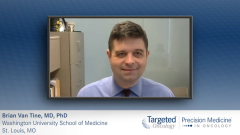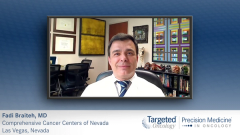
GIST Treatments: A Multidisciplinary Approach
Experts discuss the role of multidisciplinary management for patients with gastrointestinal stromal tumors (GISTs).
Brian Van Tine, MD, PhD: I think these emails, and I think our field, in general, is very friendly. This has all helped a lot of patients find ripretinib on trial. I don’t have to always see a patient to make sure they get the right drug. I’m a development person, just like you are, but I think our local regional area hopefully has faith in us that we’ll support them because we need this partnership. Without this partnership between the academic centers and these large private practices, we don’t get the new drugs. I’ve always enjoyed these conversations, especially regarding GIST [gastrointestinal stromal tumor], because it gets complicated. It’s very complicated with all of these drugs.
Fadi Braiteh, MD: While we are talking about this partnership with other colleagues in medical oncology, maybe it’s a good time to remind people, and I would like your input too, that the surgical oncologist is not out of the equation in GIST. In fact, for neuroendocrine tumors and GIST, surgical oncologists, hepatobiliary surgeons, and even sometimes thoracic surgeons are very involved. This is for 2 reasons, at least in my opinion. One is, there are sometimes tumor adverse events. You start getting symptoms of obstruction. This can be relieved surgically if a patient has an otherwise good life expectancy. Of course, it offers the amazing opportunity of optimal sampling of the tumor. Would you like to comment on that?
Brian Van Tine, MD, PhD: I absolutely agree with you. I’ve always been against doing things for the 1%. If you have control over 99 tumors and 1 starts growing, you should probably remove it. In the big picture, you have 1 clonal escape. You can see where it is, and the rest is controlled by imatinib.
There was a beautiful study done a long time ago that showed that when we only had 3 drugs and you cycled back to imatinib, there were durable responders in a subset. Back when we had fewer drugs, people went on that trial. So being aggressive, being appropriate also, not taking too much to the left or too much to the right. But interventional radiologists with some modern ablation strategies, depending on the location of the GIST, is also something we do a lot of. Every patient is an N of 1 [single patient] with a lot of genomic information now. I think this multidisciplinary approach should probably never involve chemotherapy or radiation therapy, unless it’s for pain. That is probably the most optimal way to care for a patient with GIST on their journey.
Fadi Braiteh, MD: I agree. It’s a fascinating tumor model for a multidisciplinary approach. It’s a fascinating model that is not only multidisciplinary, but recurrent multidisciplinary, ongoing. This really requires teamwork. I share most of patients who have GISTs with academic centers, and my local and my out-of-state surgical oncologists.
I had a case where I did identify a germline mutation. There are certain hereditary cancers that involve things I don’t see that much. However, I read about them. I remember at some point, the NCI [National Cancer Institute] had a study about a hereditary cancer syndrome that was GIST-specific. Why is this important? Not only to help the patient, in my opinion, but in the community if you identify these, they become a treasure of information to learn more about how we can find a new treatment that not only applies to these patients but patients affected by sporadic aberrations.
Transcript edited for clarity.















































